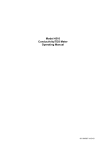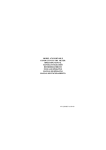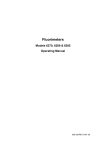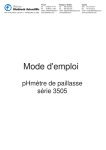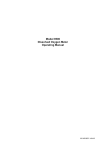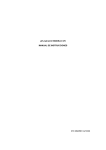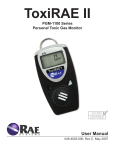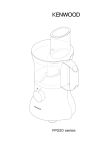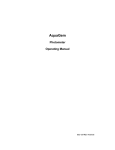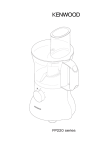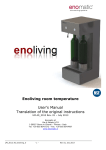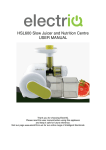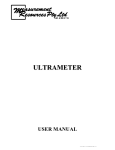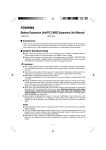Download MODEL 970 DISSOLVED OXYGEN METER OPERATING
Transcript
MODEL 970 DISSOLVED OXYGEN METER OPERATING MANUAL 970 350/REV A/10-03 MODEL 970 DISSOLVED OXYGEN METER OPERATING MANUAL CONTENTS Introduction Specification Installation Displays Controls Preparation for Use Operation Calibration Performing Measurements Data Storage Good Practice Guidelines Maintenance Troubleshooting Guide Battery Replacement Optional Accessories Auto Shut Off Health & Safety EC Declaration of Conformity 1 1 2 2-3 4 5 6 6-8 8 9 10-11 11-12 12-14 14 14 14 15 16 MODEL 970 DISSOLVED OXYGEN METER OPERATING MANUAL INTRODUCTION The Model 970 is a general purpose, hand held Dissolved Oxygen Meter allowing accurate measurement with ease of use. The custom liquid crystal display simultaneously shows percentage dissolved oxygen or oxygen concentration (mg/l) and temperature. The dissolved oxygen reading is automatically corrected for temperature. Corrections for pressure and salinity can be entered manually. The instrument is housed in a robust, ergonomically designed case. An indication of battery life is also permanently shown on the display. An automatic switch off facility helps to conserve battery life. SPECIFICATION DO2 Ranges: -5 to 199% -5 to 25.0% -5 to 19.99mg/l Resolution: 1% / 0.1% / 0.01mg/l Accuracy: ±2% within 10°C of calibration temperature Temperature Ranges: -10 to +105°C / 14 to 220°F Resolution: 0.1°C / 1°F Accuracy: ±0.5°C / ±1°F ATC Range: 0 to +60°C / 32 to 140°F Power: 2 AA cells Size: 175(l)x75(w)x35(d)mm Weight: 250g 1 INSTALLATION Unpack the instrument and ensure the following items are present: 1. Model 970 DO2 Meter (970 201) 2. DO2/Temperature Probe (970 231) 3. 2 x AA alkaline batteries (021 007)(fitted) 4. Membranes & KCl (522 019) 5. Zero salts (983 030) Optional accessories which may have been ordered: 1. Carrying Case (033 270) DISPLAYS gL-I 1. Primary display - 3½ digit display providing direct readout of % oxygen saturation, % air saturation, mg/l oxygen. Underrange (-1) and Overrange (1) symbols will be displayed if the instrument is reading outside the ranges as shown below: Primary Ranges: % oxygen saturation -5 to 25.0% % air saturation -5 to 199% mg/l oxygen -5 to 19.99mg/l 2 2. Secondary display - 4 digit display showing temperature (manual temperature compensation value if used with a non-standard sensor, or ATC temperature using the standard probe) in °C or °F. Manually adjusted pressure values (Bar) and salinity values (g/l) will be shown when the relavant mode is selected. 3. CAL annunciator - indicates when a calibration is being performed. 4. Battery Life Indication - 4 levels will be shown ranging from 25%, 25-50%, 50-75% and 75-100%. Sensor calibration data and user parameters are retained during battery replacement. 5. Mode annunciator - indicates which mode of operation is selected. 6. MAN - this is displayed to indicate when manual temperature compensation (only operates with nonstandard probes or if the temperature sensor in the probe is defective), salinity or pressure value adjustment is being performed. 7. RCL annunciator - this indicates that the displayed reading is a stored value recalled from internal memory. 3 CONTROLS STO RCL STO stores the current data reading. RCL enters recall mode to view the stored readings. I:O Switches the instrument on and off. This key should be pressed and held for 1-2 seconds to operate. The instrument will automatically switch off after 30 minutes if no key is pressed. Back light. Pressing this key will illuminate the back light for 10 seconds. It should be noted that, if used excessively, this will degrade battery life. 56 Enables manual setting of DO2 calibration values when performing a calibration, and adjustment of the manual temperature compensation value, pressure and salinity. CAL This key is used to select and perform DO2 calibration. MODE This key changes the primary measurement parameter from %DO2 to mg/l, as required. When temperature is displayed, holding this key for 3 seconds changes the display to read in °C or °F. 4 PREPARATION FOR USE NOTE: Prior to using the chemicals listed, please refer to the Health & Safety information at the rear of the manual. The probe is delivered with the membrane module detached. Prior to use the membrane module must be fitted to the probe body. A protective sheath is also supplied. This should be fitted to the probe when not in use. The sponge contained within the sheath should be wetted with deionised water prior to fitting. This covers the membrane and keeps it wet, thus preventing the electrolyte filling from drying out. 1. 2. 3. 4. Remove the protective sheath from the probe. Take a membrane module and hold in the vertical position. Fill with the electrolyte solution (5% KCl) supplied with the instrument. Ensure no air bubbles are trapped in the bottom of the membrane cap. Whilst still holding the module upright, screw the probe slowly down onto the thread, allowing the excess electrolyte to escape through the screw thread. Ensure no air bubbles are present and that the membrane is not creased. The probe should be connected to the instrument and left for 30 minutes to polarise, with the tip immersed in a beaker of water. To maintain polarisation and to enable immediate use, it is recommended that the sensor should be permanently connected to the instrument. If the sensor is to be kept in extended storage, the membrane cap should be removed and rinsed with water, and the sensor tip cleaned. The probe should be stored dry without the wetting sheath fitted. 5 OPERATION Connect the DO2 probe to the instrument. Switch the instrument on by holding down the I/O key for 1-2 seconds. All display segments will be illuminated for approximately 2 seconds. An internal self check routine is run during this display and on successful completion normal operating mode is activated. The display will either power up in %DO2 or mg/l mode depending upon previous usage. %DO2 MODE This gives a direct readout of the %DO2 of the sample under test as either % oxygen saturation or % air saturation. When the instrument is calibrated to a value of <25.0% the resolution will automatically increase to 0.1%. CALIBRATION Prepare a zero oxygen solution by dissolving the contents of the vial of sodium sulphite supplied with the instrument (983 030) in 150mls of water. Allow to stand for a few minutes prior to use. Press the CAL key. Immerse the probe in the zero solution and stir gently for approximately 2 minutes. Once the reading has stabilised press the Cal key. The instrument automatically detects the zero solution and will calibrate the reading to zero % dissolved oxygen, which will cause the primary display to read zero. Remove the probe from the zero solution and rinse thoroughly with deionised water.. % Air Saturation This will directly assign a percentage dissolved oxygen to air saturated water and further readings are then given as a percentage of this air saturated water sample. All measurements in this range are given to a resolution of 1%. Calibrate the probe in zero solution as above. 6 Fill a suitable container with a sample of clean water. Press the Cal key. Hold the probe so that the membrane is close to, but not touching the surface of the water (approximately 1 cm above). Once the reading has stabilised press the Cal key. This will cause the primary display to read 100% DO2 . % Oxygen Saturation This will give a reading of 20.9% in air where 20.9% is the amount of oxygen as a percentage of oxygen in air and will give a reading directly as a percentage of oxygen in the sample. All measurements in this range are given to a resolution of 0.1%. Calibrate the probe in zero solution (refer page 6). Fill a suitable container with a sample of clean water. Press the CAL key. Use the 56 keys to adjust the primary display to read 20.9%. The MAN annunciator will be displayed. Hold the probe so that the membrane is close to, but not touching the surface of the water (approximately 1 cm above). Once the reading has stabilised press the CAL key. The instrument measures the manually entered value (20.9%). Once a calibration value is set manually the instrument will automatically calibrate to this value until an alternative value is entered. mg/l If measurements are to be performed in mg/l it will be necessary to enter the current barometric pressure. and salinity values. Barometric Pressure Press the MODE key until the secondary display shows the BAR annunciator for barometric pressure. Adjustment to the correct value can be made by using the 56 keys. 7 Fill a suitable container with a sample of clean water. Press the Cal key. Hold the probe so that the membrane is close to, but not touching the surface of the water (approximately 1 cm above). Once the reading has stabilised press the Cal key. This will cause the primary display to read 100% DO2 . Press the Mode key to display pressure corrected mg/l readings. Salinity The oxygen dissolved in water decreases with increasing salinity when making measurements in mg/l. If measurements are made in % saturation then no correction is required. Press the Mode key until the secondary display shows the g/l annunciator for salinity. Adjustment to the correct value can be made by using the 56 keys. The instrument is now ready to perform sample measurements. PERFORMING MEASUREMENTS Select the mode required and immerse the probe in the sample to be measured (40mm depth minimum). A flow rate of 15cm/min in the sample is required, to avoid errors due to oxygen starvation at the membrane. If the flow rate is insufficient then the sample should be stirred (either by a gentle stirring action with the probe or by use of a magnetic stirrer). 8 DATA STORAGE The 970 can store up to 32 readings. Storage is intiated by manual key press. Storing Data Pressing the STO key stores the current reading in the next available data location. The storage location is indicated by Sto and a number (1-32) momentarily displayed prior to the data point. The results are stored sequentially until the memory is full. When all 32 data locations are filled, the next stored reading will overwrite the result previously stored in position 1. The stored data is retained in the event of battery failure and during battery replacement. Recalling Data Pressing the RCL key recalls the last stored reading on to the display. The instrument is now in RCL mode, indicated by the RCL annunciator at the top of the display. The 56 keys are used to select previously stored data. The storage location is indicated by rCL and a number (1-32) momentarily displayed prior to the data. To clear all readings press and hold the CAL key (>3 seconds) while in RCL mode. When all stored readings are cleared the display will momentarily show CLr ALL. The instrument will then return to the main operating mode. If storage locations are empty and the RCL key is pressed, the display will show ALL CLr. NOTE: It is not possible to delete individual stored readings. 9 GOOD PRACTICE GUIDELINES 1. Ensure the membrane is kept wet at all times. When not in use the probe should be stored with the tip in a beaker of deionised water. For longer periods (overnight) the protective sheath should be fitted, with the sponge insert soaked in distilled water. This will prevent the electrolyte fill solution from drying out due to loss of water through the porous membrane. 2. Ensure the probe is polarised prior to use. It is essential to perform this procedure after replacement of the membrane or probe. A 30 minute period of polarisation is required. 3. When replacing the membrane ensure no air bubbles are trapped in the electrolyte fill solution and that the membrane is not creased or damaged after fitting. If the probe response is sluggish, or the readout is unstable after membrane replacement, clean the anode and cathode (refer Maintenance). 4. The probe is fitted with a temperature compensating element. This is housed underneath the silver ring on the probe body. Always ensure the probe is immersed in solution to a depth suitable to cover this ring. Allow sufficient time for these to respond if measuring samples with varying temperatures or where sample temperature is significantly different to ambient temperature. 5. Ensure the sample is moving across the membrane at a speed greater than 15cm/min to avoid oxygen starvation at the membrane. If the flow rate is insufficient then the sample should be stirred (e.g. either by a gentle stirring motion with the probe or with a magnetic stirrer). 6. When using the probe in liquors, sludges or polymers a coating may be deposited on the membrane, causing slow response or drifting. This can be reduced by rinsing the probe in deionised water, or a suitable solvent for the sample, followed by a rinse with deionised water after each test. 10 7. Ensure the probe is rinsed in deionised water after each test. 8. When measuring in mg/l (ppm) results are pressure dependent and determinations carried out at pressures other than 760mm/Hg will need to be compensated. 9. When measuring in mg/l (ppm) results obtained from saline samples will need to be adjusted for salinity. MAINTENANCE Although the oxygen probe is supplied in a clean and tested condition it may, after some time, become sluggish or erratic due to contamination of the gold cathode, silver anode or membrane. a) Membrane Replacement 1. Hold the probe in a vertical position and carefully unscrew the membrane module. 2. Take the new membrane module and holding it in a vertical position, fill with electrolyte (5% KCl). 3. Still holding the module in a vertical position, screw the probe slowly down onto the thread, allowing excess electrolyte to escape through the screw thread. Ensure no air bubbles are present and the membrane is not creased. b) Cathode and Anode Cleaning The gold cathode tip can be re-polished using a fine abrasive (“crocus paper”) material. Lay the abrasive sheet on a flat surface, hold the probe in a vertical position and gently polish by moving the tip over the sheet in a circular motion. A toothbrush dipped in diluted ammonia solution will remove any deposits from the silver anode. For stubborn deposits a very fine abrasive similar to that used for cleaning gold connectors in electronics may be used sparingly. Rinse with deionised water prior to re-assembly. If the probe is not to be used for 24 hours, store with the protective sheath fitted to prevent the electrolyte from drying out due to evaporation through the membrane, 11 which is porous to water vapour as well as oxygen. If the probe is disconnected from the unit or a new membrane has been fitted, it will be necessary to allow the probe to polarise before stable readings can be obtained. Polarisation will normally be achieved within 30 minutes. TROUBLESHOOTING GUIDE FAULT PROBABLE CAUSE No power Battery failure Replace batteries Battery polarity incorrect Refit batteries Unstable display DO2 probe defective Probe not fitted correctly Calibration to 100% with zero solution ACTION Replace DO2 probe Check connections Repeat zero calibration procedure with fresh zero solution. Calibrate the probe to 100% in air Display Intermittent or no Check electrode permanently connection connection under or to instrument over range DO2 probe defective Replace DO2 probe Contaminated solutions Replace solutions Calibration on low oxygen Recalibrate with the probe concentration in air Temp. value DO2 probe defective incorrect Replace DO2 probe I/O switch I/O key not held down not working long enough Batteries not fitted Retry holding key for 2 seconds Fit batteries 12 FAULT 56 keys not working Back light not on/goes out PROBABLE CAUSE ACTION Operating in incorrect Refer to operation section of manual mode 10 second time elapsed/ normal function Recheck Unable to Incorrect mode of adjust manual operation temperature Reselect mode Unable to calibrate Erratic or slow response Clean the tip, replace membrane module Refill or replace membrane Sensor tip may be tarnished (Ag or Au) Air bubbles inside the membrane cap Membrane damaged Coating of membrane due to use in oils or slurries, strong solvents, acids or alkalis DO probe defective 2 Replace membrane Replace membrane Replace DO probe 2 Inaccurate Zero solution will calibration absorb oxygen if left Erratic or slow open response Use fresh zero solution and recalibrate Measurement Incorrect salinity errors Calibration error Contaminated solution Incorrect standards Incorrect barometric pressure Reset salinity values Recalibrate instrument Replace solution Replace standards Reset barometric pressure 13 FAULT PROBABLE CAUSE ACTION Unable to calibrate to 100% Calibrating to previously set value Manually reset value to 100% Permanently Membrane not fitted reading zero Membrane damaged Membrane not filled with KCl DO probe defective Fit membrane Replace membrane Fill or replace membrane Replace DO probe 2 2 If a fault is identified during the start up self check routine an error code will be displayed. This indicates an internal hardware or software problem. In the event of this, please contact your local distributor or service agent. BATTERY REPLACEMENT Switch the unit off using the I/O key. To fit new batteries; loosen the battery compartment cover (the screws are captive in the cover), remove and carefully discard the used batteries. Fit the new batteries, type R6, AA or AM3, ensuring the correct polarities are observed, as indicated on the moulding. Refit the battery compartment cover, ensuring that the fixings are secured into place, but are not overtightened. OPTIONAL ACCESSORIES The following list of items are available for use with the Model 970: 033 270 Carry case 522 019 Membrane kit and KCl 541 553 KCl solution (30ml) 983 030 Vial of zero powder 522 016 B.O.D. bottle attachment 2.5° 522 017 B.O.D. bottle attachment 3.0° 522 018 B.O.D. bottle attachment 6.0° AUTO SHUT OFF This will occur after 30 minutes if no key is pressed. 14 HEALTH & SAFETY INFORMATION PRODUCT: Potassium Chloride Solution HEALTH HAZARD - May be harmful if ingested in quantity, causing nausea, vomiting and diarrhoea. May irritate eyes. FIRST AID Eyes: Irrigate thoroughly with water. If discomfort persists OBTAIN MEDICAL ATTENTION. Lungs: Remove from exposure. Skin: Wash off thoroughly with soap and water. Mouth: Wash out mouth thoroughly with water. In severe cases OBTAIN MEDICAL ATTENTION. PRODUCT: Sodium Sulphite Anhydrous HEALTH HAZARD - If ingested in quantity can cause gastric irritation, colic, diarrhoea, central nervous system depression and death, due to liberation of sulphur dioxide. Irritating to skin, eyes and respiratory system. Used in controlled quantities as a food preservative and antioxidant. FIRST AID Eyes: Irrigate thoroughly with water for at least 10 minutes. OBTAIN MEDICAL ATTENTION. Lungs: Remove from exposure, rest and keep warm. In severe cases OBTAIN MEDICAL ATTENTION. Skin: Wash off thoroughly with water. Remove contaminated clothing and wash before re-use. In severe cases OBTAIN MEDICAL ATTENTION. Mouth: Wash out mouth thoroughly with water and give plenty to drink. In severe cases OBTAIN MEDICAL ATTENTION. 15 EC Declaration of Conformity JENWAY Model 970 Dissolved Oxygen Meter complies with the following European Standards: EN 50081-1:1992 Electromagnetic compatibility - Generic emission standard EN 61326:1998 Electrical equipment for measurement, control and laboratory use - EMC requirements. EN 61010-1:1993 Safety requirements for electrical equipment for measurement, control and laboratory use Following the provision of: EMC Directive - 89/336/EEC and Low Voltage Directive - 73/23/EEC Carl Warren Technical Manager, Jenway, Gransmore Green, Felsted, Dunmow, Essex, CM6 3LB, England 16



















